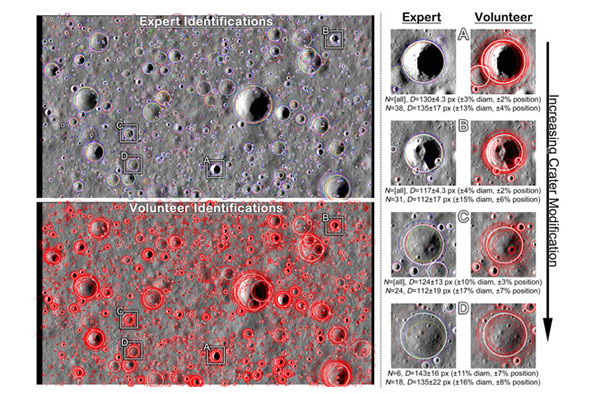Counting Craters: YOU Can Help Map the Moon
Left two panels are the full NAC areas analyzed in this study with markings overlaid. Top image shows expert markings, bottom shows volunteer data. Color circles are the individual markings and the white, thicker circles are results from a clustering algorithm. On the right side, four example craters are shown in detail with expert markings (left) and volunteer data (right); the craters are in order of increasing modification / degradation. Captioned below each pair is the number (N) of persons who marked that crater and the mean diameter (D) with standard deviation. Values in parentheses are relative standard deviations.
Crowdsourcing is the 21st century way of solving big problems. We crowdsource answers to our computer problems, funding for our start ups, and even science itself. A new study comparing the accuracy of crater counting from thousands of volunteers with that of experts shows that crowdsourcing science works.
Citizen science is the practice of everyday people helping with science research. It has a long and storied history, from the first people to ask “why?” through the natural philosophers of Newton’s time to the avid amateur astronomers and birders of today. With the advent of new online tools, however, participating in a citizen science project has never been easier.
CosmoQuest is a citizen science website that is building a community of people learning and doing science. It provides a web-interface that allows anyone with an internet connection to explore data from several NASA spacecraft of three worlds in our solar system: the moon, Vesta, and Mercury. As people mark craters and surface features, they all want to know, are we doing a good job?
Stuart Robbins of CU Boulder led the study of crater-counting by the citizen scientists of CosmoQuest and eight expert crater counters with varying levels of experience. Crater counting, it turns out, really is a subjective process, and the experts differ quite a bit from each other when analyzing the same patch of surface with their favorite tools. This gives insight into the history of this science and demonstrates the level of uncertainty in such measurements.
Then, the results of citizen scientists were aggregated and compared to the average of the experts’ counts. Turns out, the volunteers do just as well as the experts! There is an advantage, however, in the nature of crowd-sourcing. A lot of volunteers can map the moon a lot faster than a few researchers.
Why is counting craters so important, anyway? The relative ages of planetary surfaces can be determined by crater counts where, generally, older surfaces have more craters per unit area than younger surfaces. The Moon, unlike Earth, has undergone very little geologic change in its history, so the impact history has been preserved even while most of Earth’s has been erased.
Though the moon is so familiar to us, the Lunar Reconnaissance Orbiter, or LRO, has given us new and deeper insight than we ever had before. The LRO images being analyzed by volunteers have the highest precision available, such that you could see a really tall person making a snow angel! Citizen scientists are mapping craters 35 feet (11 meters) in diameter and larger.
There is still a LOT of moon to cover with over 500 million craters estimated visible on the surface. So really, the science is just getting started over at CosmoQuest. In addition, there are still the asteroid Vesta and the planet Mercury to map there, too, thanks to data from Dawn and MESSENGER.
It doesn’t take a PhD to do science, just as it doesn’t take one to think scientifically about problems in everyday life. For this specific science, all you have to do is watch a short tutorial video and get started. There are deeper levels of involvement, from Hangouts to forums and lesson plans for teachers. And CosmoQuest is just one of many, many citizen science projects out there that range from cosmology to microbiology. It’s a darn big Universe, so it’s good to know that we can explore it together.
Check out the video explainers for this paper: short version | long version
This work is published in the journal Icarus and a preprint will be available soon from arXiv.org.
Full disclosure: This author works for CosmoQuest as the informal education lead. (Mar 14, 2014 11:44 AM ET // by Nicole Gugliucci)












